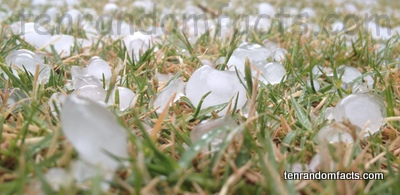Falling, covering and destroying.
- Hail is frozen, solid water droplets that fall from the sky. A hailstone is one lump of ice.
- Normally, the heavier and bigger the hailstone is, the higher in the sky the hailstone falls from.
- Hailstones have a diameter from at least 5 mm (0.2 inches) and can be as big as 20 cm (7.9 inches) when they reach the ground and can weigh more than 500 grams (1.1 lbs).
- Hailstones can join together and can be found in weird and interesting shapes.
- Hail forms at the top of cumulonimbus clouds (thunderclouds), due to the freezing air temperature, as a result of a strong updraught.
- It is much more likely to hail along mountain ranges.
- Many names are given to sizes of hailstones. These names range from a pea to a bowling ball to a cent coin or a penny size.
- Hailstones can damage vehicles, street lights, rooves of buildings, crops, and can hurt or potentially kill, both people and animals.
- In Europe during the Middle Ages, people attempted to prevent hail and its damaging effects by shooting cannons and ringing loud church bells, though these methods were not effective.
- Although people have tried, nothing has been invented that can stop hail from falling, although the use of hail cannons, specifically designed for the purpose, are said to help prevent it.






Your website rocks!
hey cris i love this so much
I love this website I love it more than my mom